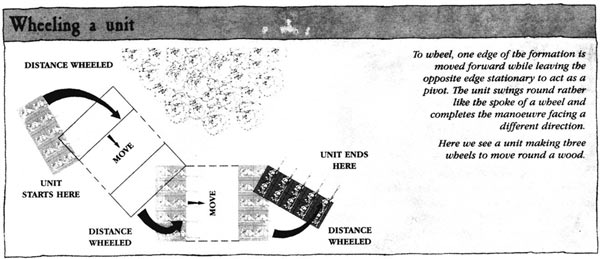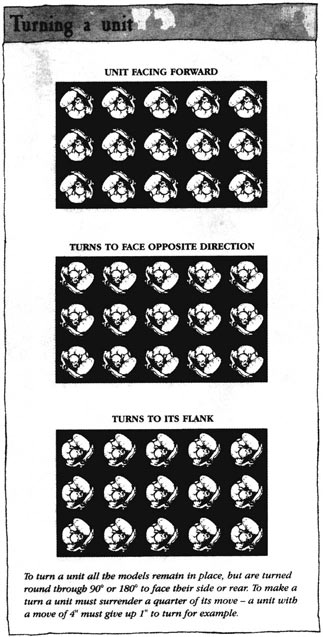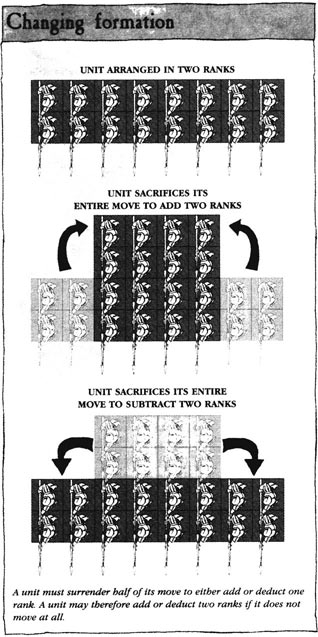Troops move and fight in a tight formation of one or more ranks. Such a formation is often referred to by an appropriate title such as a regiment or, in the case of cavalry, a squadron, or it can simply be called by the cover-all term – unit. When a unit moves around the battlefield it must maintain its formation, which means that models are not free to wander off on their own. The formation can move straight forward as a body perfectly easily, but if it wishes to change direction then it must make a manoeuvre. There are three specific types of manoeuvre that enable a unit to turn about or rearrange its ranks: wheel, turn and change formation. In addition there is a fourth special manoeuvre called reforming. 
To wheel, the leading edge of the formation moves forward, pivoting round one of the front corners. The unit swings round like the spoke of a wheel and completes the manoeuvre facing a different direction. 
When it wheels, the entire unit counts as having moved as far as the outside model. Once the wheel is complete, you may use any movement that the unit has remaining. For example, a unit of Empire Spearmen might wheel 2" to the left and move 2" straightforward, for a total move of 4”. A unit can wheel several times during its move as long as it has enough movement to do so and is not charging. A unit that is charging is only able to wheel once to align itself to the enemy, as described later. To turn a unit, all the models remain in place but are turned around through 90" or 180" to fare their side or rear. To make a turn, a unit must surrender a quarter of its move. For example, a unit with a Move of 4" must give up 1" in order to turn. A unit is allowed to turn several times during its move unless it is charging or marching. When a unit is turned to face its side or rear, its leader is automatically rearranged into the front rank along with the Standard Bearer, Musician and any other characters that are in the unit. If there is not enough space within the ranks, models can be rearranged into the rear ranks as the player wishes. A unit of troops can also change its formation by adding or reducing the number of ranks in which it is deployed. For example, a unit that consists of two ranks may increase its depth to three ranks by moving models from the front two ranks to form a new third line. A unit must surrender half of its move to either add or deduct one rank. A unit may add or deduct two ranks if it does not move at all. 
When redeploying ranks in this way it is important to remember that a unit always has the same number of models in each rank, except for the rear rank which may contain the same or fewer models. A rear rank is still a rank whether it is full or contains only one model, although only ranks of four or more models are considered to be of any value in close combat, as described later. A unit of troops can change the direction in which it is facing and rearrange its formation all at once by means of a manoeuvre called reforming. The leader issues the order to adopt, new formation and the troops mill about until they assume their new positions. A unit of troops can reform during its Movement phase as long as it is not in close combat, and is otherwise free to move as it wishes. The player declares that the unit is reforming and regroups it into a new formation. Keeping the centre of the unit the same, arrange the unit into a new formation of as many ranks as you please facing whichever direction you wish, as long as none of the models in the unit move more than twice their Movement rate (ie, Men with Move 4 can move up to 8"). Character models, Standard Bearers and Musicians must still be placed in the front rank of the unit as normal. A unit which reforms cannot move that turn because it takes the entire Movement phase to reform. Also, reforming troops cannot shoot with missile weapons that turn because they are too busy assuming their new formation. Other actions, such as Wizards casting spells, are still allowed. |